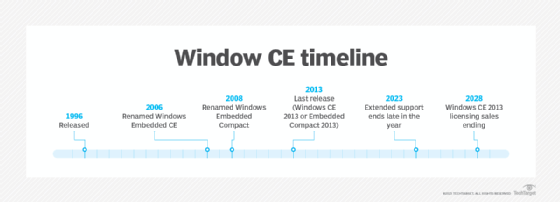Windows CE
What is Windows CE?
Windows CE is a version of Microsoft's Windows operating system (OS) that was designed for mobile and other space-constrained devices with small footprints. Although Microsoft does not explain what CE stands for, it is reported to have originally been an acronym for Consumer Electronics or Compact Edition.
A legacy OS with a venerable history, Windows CE was first released in November 1996. Since then Windows CE has been installed on industrial, medical, consumer and other electronic devices. Windows CE was renamed Windows Embedded CE in 2006 and Windows Embedded Compact in 2008. Windows CE 2013 (or Embedded Compact 2013), the OS' last release, is slated to reach the end of extended support in late 2023. Microsoft will continue license sales for Windows CE 2013 until 2028. However, users can use devices already running on the OS for an indefinite period.
Developed for pocket-sized and Windows Embedded devices, Windows CE is one of the earliest OSes developed for space- and memory-constrained mobile devices.
Microsoft has licensed Windows CE to original equipment manufacturers, who could use the OS to provide a technical foundation for creating (or modifying) the user interfaces (UIs) and user experiences in their own hardware. Many devices now run on Windows CE, including cameras, industrial controllers, point-of-sale terminals and communications hubs.

The evolution of Windows CE
In the early '90s, the full desktop versions of Windows could not run on newly emerging pocket-sized devices. By 1996, mobile computing was taking off. To support these smaller devices, Microsoft developed Windows CE. In doing so, they brought the user-friendly Windows 95 graphical user interface (GUI) to mobile computing, albeit in an avatar that couldn't run programs designed for desktop Windows 95 or Windows NT. However, most Windows CE installations included pocket versions of many Microsoft Office applications, such as Word, Excel and PowerPoint.
Over time, the OS provided the foundation of many mobile computing and smartphone products that Microsoft later developed. Microsoft's first Windows Mobile platform and its second Windows Phone platform were based on Windows CE. In fact, all Windows Phones were Windows CE until the release of the Windows Phone 8.
Features of Windows CE
Windows CE was optimized for devices with small memories. Almost from the beginning, it retained Windows 95's user-friendly GUI, complete with the Start menu, taskbar and familiar desktop logos. It also included many of Microsoft's popular applications, although they were trimmed down to match the smaller memory, limited storage and slower speeds of the mobile, pocket and handheld devices of that era. The OS also emphasized low power usage and was compatible with flash memory storage. When it was released, Microsoft intended it to be usable with a full QWERTY keyboard, making it different from the personal digital assistant OSes of that era.
Windows CE was offered to hardware vendors in source code form so they could modify it for their hardware. Later, Microsoft developed an integrated development environment named Platform Builder, which can be used to build platforms for embedded devices using the Windows CE .NET OS. Platform Builder provides a single integrated interface and numerous tools to design, create, build and test Windows CE-based platforms and projects. Microsoft also offers many core components of Windows CE in binary-only form. These components do not need to be adapted to specific hardware environments, so in these cases, Platform Builder is not required.
Windows CE technical details
Windows CE is a 32-bit multitasking, multi-thread pocket version of Windows for mobile devices. Like the regular Windows OS, Windows CE also used the same Win32 programming interface. But unlike regular Windows, Windows CE could run on less than 1MB of RAM, keeping with its primary use case: small-footprint mobile and embedded devices.
From its earliest version, Windows CE could run on many different processor architectures, including SH3, MIPS and ARM, unlike the full desktop versions of Windows operating systems that were tied mostly to the Intel x86 CPU architecture. In addition, Windows CE supported almost all Windows technologies, including .NET Compact Framework, MFC, COM, ActiveX and DirectX.
It also came preinstalled as firmware on the ROM chips built into portable devices from various vendors. Users could synchronize the files on their Windows CE mobile devices with Windows-powered desktop PCs using an RS-232 serial cable or infrared connection, later using network-based syncing.
Numerous components of Windows CE are available in its source code through the Shared Source initiative. The code can be modified to work with specific platforms. Nonetheless the OS remains a closed source OS, like all other Microsoft products.
Windows CE 2013 and CE App Container
The latest version of Windows CE, Windows CE 2013, supports x86 and ARM processors with a board support package directly. Additionally, it features a Windows CE App Container that runs a Windows CE 2013 instance on top of a Windows 10 IoT Core, the smallest version of the Windows 10 OS optimized for smaller devices with fewer resources such as displays. The container allows most Windows CE users to run their existing Windows CE applications on Windows 10 internet of things.
Other options for transitioning from Windows CE 2013 include versions of Android and Linux. The alternative chosen depends on the customer's needs.
See advantages and disadvantages of mobile devices in business and 7 key benefits of mobile device management for businesses.








